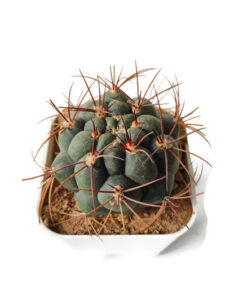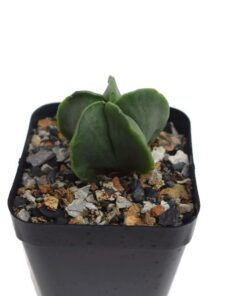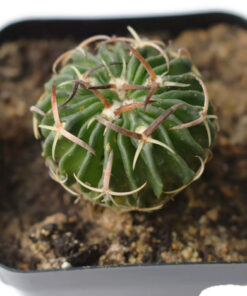Gymnocalycium pflanzii Cactus Live plant
₹750.00
Out of stock
Email when stock available
Gymnocalycium pflanzii Origin and Habitat: South-east of Bolivia(Cochabamba, Chuquisaca, Potosí, Santa Cruz and Tarija), North-West of Paraguay (Alto Paraguay and Boquerón) and North of Argentina (Provinces of Salta, Jujuy and Tucumán)
Gymnocalycium pflanzii Altitude: It can be found at elevations of 500 to 2,500 metres above sea level.
Habitat: Grows often semi-buried in in deep rich sandy soil, rather in sunny rocky areas, on slopes or under spiny shrubs in the sotobosque, at the border and clearings of the dry Chaco forest. Gymnocalycium pflanzii has a wide range, is abundant and the threats that affect part of its range are minor. Subsistence farming, agriculture and goat grazing are minor threats to the species in parts of its wide range.
Gymnocalycium pflanzii Description: Gymnocalycium pflanzii is a solitary or slowly clustering cactus, with peculiar spine clusters characteristically bent backward in a distinctive fashion.
Stem: Flattened-globose, 10-15 (25) cm in diameter, 10cm tall pale green, to olive green that can tinge of orangish purple in full sun. The epidermis has a velvety appearance. The apex is slightly depressed and woolly.
Ribs: 10 to 12 thick, large, divided into polygonal rounded (not chinned) tubercles, separated by arched furrows.
Roots: Fibrous
Areoles: Large long, oval 10 by 14 mm broad, with cream-yellowish wool, then blackish dismantling with time.
Spines: Strong, very stiff, bent backward, initially blackish with a brown base then becoming grey-pinkish to whitish brown with black point.
Radial spines: (5-)7-9 up to 25 mm long
Central spines:One (or two) of the same length.
Flowers: Infundibuliform near the apex, diameter and height 45-50 mm. Pericarpell dull green very short. External tepals spatulate, slightly bent outward , white with brownish green midrib. Inner tepals intern narrower, spatulate and slightly denticulate, white with carmine/pink purplish throat. Style carmine with carmine pink 10-12 lobes. Pollen yellow.
Fruits: Globose of approximately 2 cm of diameter, becoming red carmine with maturity. Pulp intense cherry-red.
Seeds: Microsemineum type, section pirisemineum, very small (0,6 X 0,4 mm), testa reddish shining and smooth.
Remarks: It is a very variable species with a wide distribution and several controversial varieties, forms and subspecies has been described. Of them only three or four has been recognized: subsp. argentinense H.Till & W.Till from Gonzales, Salta, Argentina, subsp. zegarrae (Cárdenas) G.J.Charles and subsp. dorisie coming from Tarija, Bolivia.
Be the first to review “Gymnocalycium pflanzii Cactus Live plant” Cancel reply
You must be logged in to post a review.

























Reviews
There are no reviews yet.